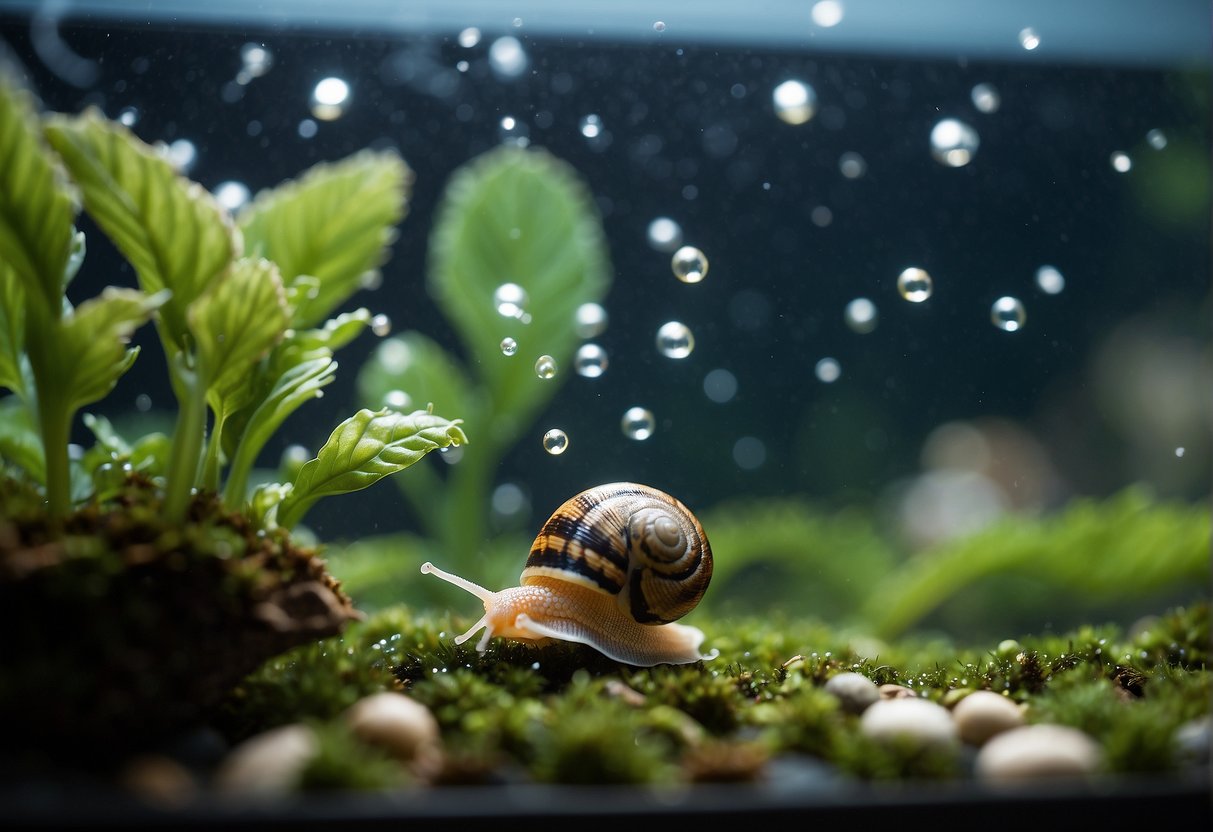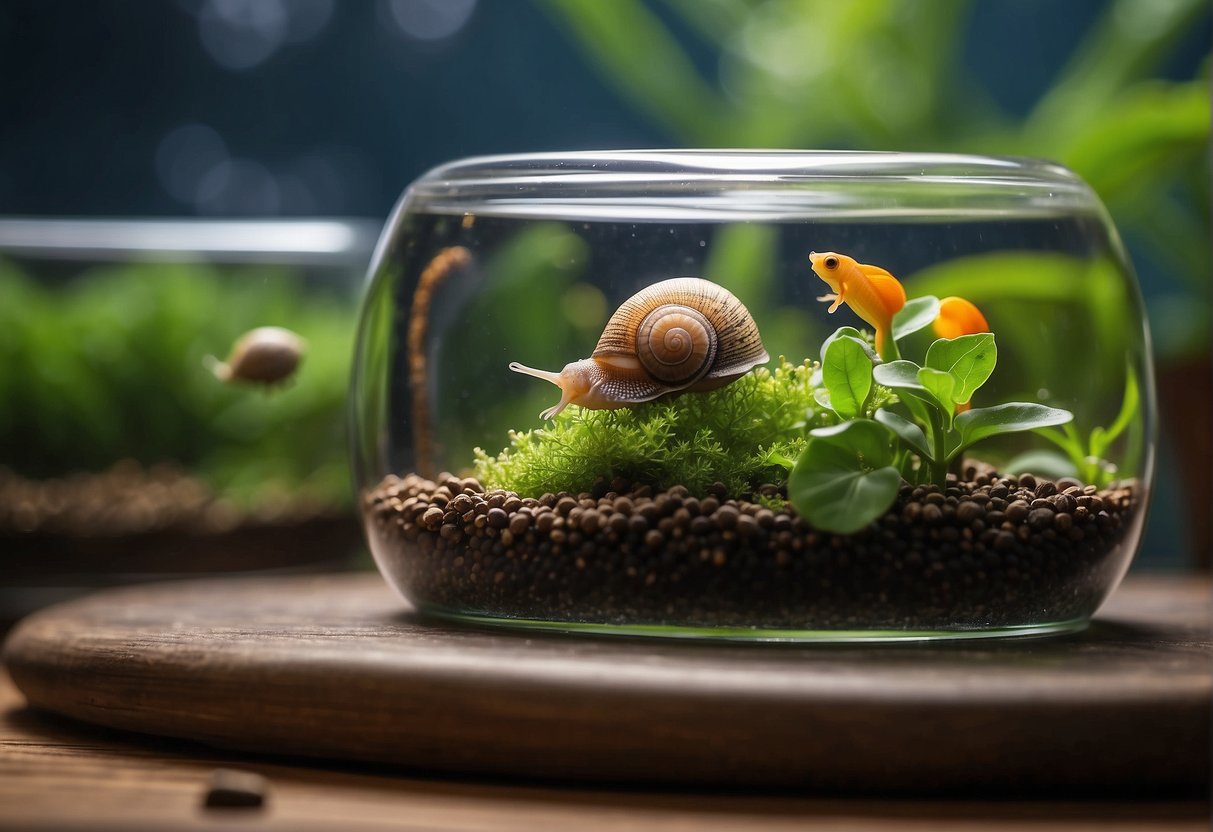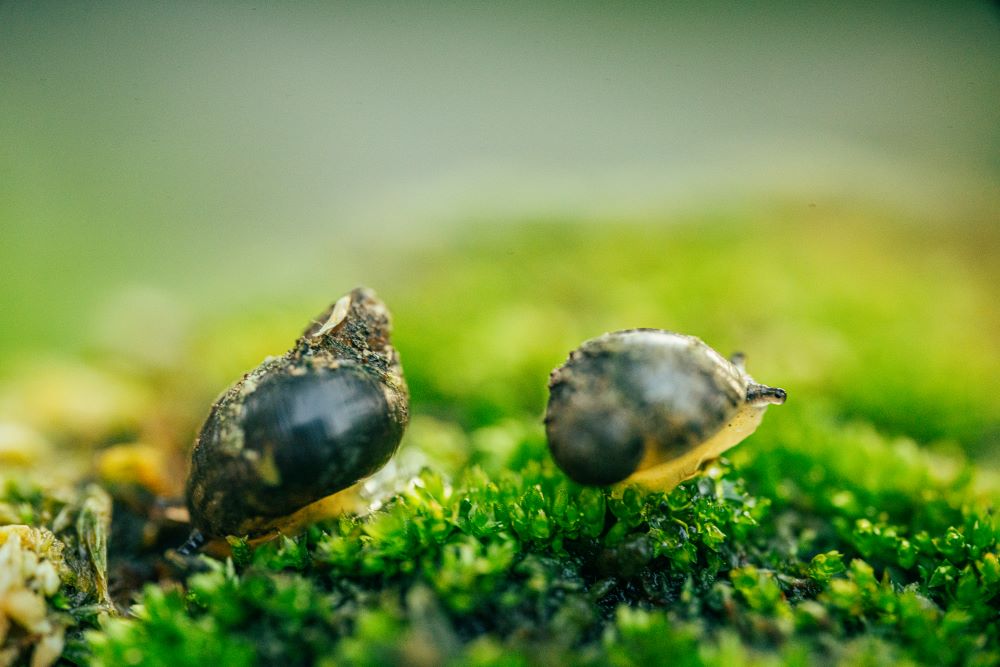Keeping betta fish in the same tank as other marine life can be tricky, which is why it can be hard to find tankmates for them. Luckily, many freshwater snails and betta fish can thrive in similar conditions, and this makes caring for the betta and snails much simpler.
But then, an important question comes up regarding maintaining a healthy environment for both: What and how should you feed the snails?

Naturally, snails help clean the tank by consuming algae, dead plant matter, and leftover fish food, providing a cleaner and more hospitable environment for the betta fish. Still, I make it a point to keep the betta tank parameters are snail-friendly. That, and providing just enough snail food to avoid overfeeding and a potential risk of tank pollution.
But there is more to maintaining a healthy and optimal dietary balance for snails in a Betta tank, and that’s what this comprehensive guide will discuss. Let’s get rolling!
Contents
Understanding Your Betta Tank Ecosystem

In my experience, a thriving betta tank ecosystem hinges on the careful balance between the inhabitants and their environment. This balance is influenced by several key aspects comprising both biological and chemical elements, which need to be understood for the well-being of every organism in the tank.
The Role of Snails in the Betta Tank
Snails are great contributors to the balance of a tank’s ecosystem, especially through their feeding. They act as natural cleaners by feasting on algae, leftover food, and decaying plant matter, which helps in keeping the substrate free of excess waste. This activity is crucial as it helps minimize harmful ammonia and nitrate levels that can accumulate from organic decay.
Maintaining Ideal Water Conditions
Marine animals have different ideal water requirements, and betta fish and snails are no exception. Maintaining optimal water conditions is vital to their health, which means controlling a range of parameters.
The first parameter to maintain is water temperature. Ideally, it should be steady and anywhere between 76°F and 80°F. Next, you should closely monitor the water pH levels, which should be maintained around 6.5 to 7.5.
Finally, you want to make sure the ammonia and nitrate levels are right. You can take a page from my book and regularly change the tank water to achieve this. Alternatively, you can try specially designed chemical agents like Red Sea NO3:PO4-X. I also routinely use a water testing kit to monitor these parameters, ensuring the tank remains a safe habitat for its inhabitants.
Choosing the Right Snail Species
Before introducing snails to my betta tank, I had to be sure I was choosing the right species. You will find that having a suitable and compatible snail species for your betta tank greatly impacts the health and balance of the ecosystem.
Common Snail Types for Betta Tanks
- Nerite Snails: These snails are renowned for their algae-eating abilities and their inability to breed in freshwater, making them a popular choice for betta tanks. They need brackish water to reproduce, so overpopulation is not a concern in freshwater.
- Mystery Snails: A favorite among aquarium enthusiasts, mystery snails come in a variety of colors and have a peaceful nature. They are quite large and require ample space to move about, so if you’re going for one of these, you should ensure you have a big enough tank.
- Ramshorn Snails: Recognizable for their spiraling shells, these snails are very effective tank cleaners. Their main downside is that they can reproduce very quickly if overfed, and before you know it, you could have so many snails in the tank that it might as well be a snail tank. A snail tank with betta fish inside is unsustainable. Conclusion: feed your Ramshorn snails appropriately.
- Malaysian Trumpet Snails: These snails are natural burrowers; they can help aerate and clean the aquarium substrate. However, they are known to reproduce very rapidly, so you should have population control measures at the back of your mind.
Pros and Cons of Various Snail Species

Now, let’s really get into the advantages and disadvantages of the snail species we have just overviewed.
- Nerite Snails:
- Pros: Exceptional at controlling algae.
- Cons: May attempt to escape if they are unhappy with the water conditions.
- Mystery Snails:
- Pros: Large and visually appealing; they don’t reproduce as quickly as other species.
- Cons: Their larger size means they produce more waste, which can affect water quality.
- Ramshorn Snails:
- Pros: Excellent at cleaning the tank, including glass, substrate, and plants.
- Cons: Prone to overpopulation; may eat live plants if food is scarce.
- Malaysian Trumpet Snails:
- Pros: Beneficial for substrate health and do not eat live plants.
- Cons: Can overpopulate quickly and are often considered pests.
Choosing the right species of aquarium snails for a betta tank requires considering the balance you wish to achieve between tank cleanliness and population control. You must ensure that the snail’s requirements align with your tank’s conditions and that the snails are compatible with your betta fish.
Feeding Basics for Snails and Betta Fish
When setting up a betta tank with snails, I try as much as possible to meet their dietary needs without compromising their health. Achieving the right balance of nutrients is vital for their well-being.
Providing a Balanced Diet for Betta Fish and Snails
If you want to maintain a balanced and healthy ecosystem for your snail and betta fish, providing a balanced diet is essential. Betta fish are natural carnivores that require a high-protein diet. I tend to feed mine with specially formulated betta pellets and the occasional live or freeze-dried treats like bloodworms or brine shrimp.
On the other hand, snails are herbivores, so a balanced diet for them ideally involves an assortment of plants. They already feed on the natural detritus in the tank, but you can also treat them to some blanched vegetables and sinking algae wafers.
Creating a Safe and Healthy Tank Environment
As mentioned before, the key to a thriving betta and snail habitat is a well-planned tank environment that prioritizes the creatures’ health and security. Proper setup and disease prevention are crucial. So, how do you set things up?
Tank Setup for Comfort and Security
I always start with a tank that’s at least 10 gallons to ensure ample space for both bettas and snails. You can use a smaller or bigger tank depending on how large you want your little water habitat to be. Creating plenty of hiding places is also essential.
You can do this by adding live plants and decorative shelters, which make the environment more aesthetically pleasing and provide necessary shelter for snails. This also gives them areas to scavenge without stress, replicating their natural ecology.
Water quality is critical, too. I tend to use a robust filtration system to help maintain a clean environment and to perform regular water changes to keep toxin levels low. For snails, stable water parameters prevent stress, which can lead to disease, making low-maintenance species an ideal choice for tank mates.
Preventing Disease and Stress
To minimize stress and susceptible diseases, monitoring tank conditions is crucial. Since fluctuations can cause distress to bettas and snails, you must ensure the water temperature and pH levels are consistent. You should also be keeping an eye out for signs of poor health among your tank mates.
It’s not enough to monitor and treat the fish and snails when ill. Preventive measures are famously better than curative ones, after all. Al-suited to the health needs of your snails and betta is one such preventive measure, as it contributes to their resilience against disease. The right balance of nutrients will reduce the likelihood of disease and stress in the tank’s occupants.
Introducing Snails to Your Betta Tank
Before I detail the process of adding snails to a betta tank, it’s vital to recognize the importance of acclimation and understanding tank mate compatibility. This will ensure a peaceful coexistence between your betta and the new snail inhabitants. Let’s talk about acclimating your snails to their new betta tank habitat.
Acclimating Snails to the Aquarium
Acclimating your snail to the new environment is crucial to avoid shock due to sudden changes in water parameters, no matter how slight. After all, let’s face it, you won’t necessarily be able to replicate a marine snail’s natural habitat perfectly.
Here is how I acclimate snails before releasing them into their new home with a betta:
- Float the Bag: Start by floating the bag containing the snails on the tank’s surface for about 15 minutes. This allows the water inside the bag to adjust to the tank temperature gradually.
- Add Water: Over the next 45 minutes, I add a small amount of tank water to the bag every 15 minutes to let the snails slowly acclimate to the water parameters.
- Release: I gently place the snails into the tank after acclimation.
It’s also a good practice to quarantine new snails before introducing them to the main tank to ensure they are free from parasites and diseases.
Compatibility and Coexistence
Introducing snails as tank mates for a betta can be a peaceful endeavor, but it’s contingent on the temperament of the betta. This makes it essential to assess your betta’s aggressiveness beforehand. Some bettas may be more aggressive and prone to attacking tank mates than others.
To avoid such tension, choosing snails with hard shells like nerite or mystery snails is sensible, as they are less likely to be harmed. You can also choose peaceful and non-intrusive snails to promote a harmonious tank environment. Compatibility between species is as important in my tank’s ecosystem as maintaining proper water quality and providing adequate space for all inhabitants.
Managing Snail Populations and Tank Cleaning
We mentioned before that some species of marine snails tend to multiply more readily than others. Especially when adding such snails to your betta tank, you need to be mindful of their breeding tendencies and their impact on the ecosystem, including waste management and population control. Here’s how you can approach these factors.
Controlling Snail Breeding
Overpopulation in your betta tank not only leads to excess waste production but also results in a less sustainable relationship between the snails and their territorial tankmates. So, what to do?
The easiest way to control the snail population is to limit how many snails you put in the betta tank and carefully choose species with lower reproduction rates. Apple snails, for instance, reproduce quickly at warm temperatures, which are ideal for bettas but can lead to overpopulation.
Therefore, opt for species like Nerite snails, which have difficulty reproducing in freshwater, helping to maintain a manageable snail population. The other way to keep the population in check is to periodically remove excess snails from the betta tank. You can either sell them or put them in a new tank.
Snails’ Role in Tank Maintenance
The snails in my betta tank are not just pets; they serve an important role in tank maintenance. By consuming algae, uneaten food, and detritus, snails help control waste and contribute to a cleaner environment.
However, you also have to monitor the tank’s cleanliness and perform regular maintenance, as snails can contribute to waste with their own bioload and occasional snail egg deposits. Putting fewer snails in the tank at least helps by reducing the amount of waste you have to clean.
Addressing Common Problems with Snails and Betta Fish
Several common issues tend to arise with regard to maintaining snail and betta fish tanks, often related to health and tank conditions. Identifying and addressing these issues swiftly is crucial to ensure a harmonious and healthy environment.
Identifying and Resolving Health Issues
If you notice health issues in your tank, you should first consider stress indicators in snails, which can sometimes coincide with health problems in betta fish. Signs of stress in snails can manifest as less activity or not eating well.
This can often result from poor water quality or aggressive behavior from tank mates. For betta fish, the signs include lethargy, gasping for breath, faded coloration, and lack of appetite, and such stress can lead to a weakened immune system, making them more susceptible to disease.
Maintaining optimal tank water conditions is one effective way to prevent and even combat this. We’ve already discussed maintaining water temperature, pH, and ammonia and nitrate levels. But algae growth, if unchecked, can also cause poor tank conditions and, by extension, stress or diseases.
While snails do eat algae, excessive growth can be a sign of light imbalances or excess nutrients. As such, ensure the tank isn’t exposed to too much direct sunlight and adjust your feeding regimen to reduce food waste—another potential cause of algae blooms.
Additionally, If you see signs of disease, such as unusual spots or behaviors, you can isolate the affected creature in a quarantine tank for treatment, which often includes adjusting water conditions and using medicated treatments specifically designed for snails and bettas.
Overfeeding is another common pitfall in a betta tank with snails. Both creatures can suffer from it, as bettas might become bloated and suffer from swim bladder issues, while snails can contribute to higher levels of ammonia due to increased waste. You can avoid overfeeding by measuring the food portions accurately and observing the snails’ eating habits to adjust as necessary.
Lastly, food waste must be kept to a minimum to prevent the accumulation of toxins in the tank. You can achieve this by removing uneaten food after feeding times and maintaining a regular cleaning schedule. Such diligence helps to prevent diseases linked to poor water quality and keeps your snails and betta fish in robust health.
Final Thoughts on How to Feed Snail in Betta Tank
Maintaining a tank with betta fish and snails can be both enjoyable and tasking. You have to be sure you have compatible species of betta and marine snails, ensure you have the right amount of space, provide the right nutrition, and monitor and control at least three vital water parameters to make it work.
However, once you understand all these well enough, it becomes a much easier and much more rewarding task. Hopefully, this comprehensive guide has provided all the information you need to do it right.
Frequently Asked Questions
I’m addressing common concerns regarding the care and feeding of snails in a betta tank. These answers draw from reliable care practices to help maintain a safe and nourishing environment for both your snails and betta fish.
What do mystery snails require for a healthy diet in a community tank with betta fish?
Mystery snails thrive on a varied diet comprising algae, blanched vegetables, and commercial snail pellets. In a tank with betta fish, ensure that the snail food does not contaminate the water, potentially affecting the betta’s health.
Can I keep betta fish and mystery snails together safely?
Yes, mystery snails can coexist with betta fish if the aquarium is spacious enough and the betta is not overly aggressive. Monitoring their interaction initially is important to ensure safety for both.
How can I prevent a betta fish from being aggressive towards tank snails?
Reducing aggression in betta fish towards snails involves providing ample space, hiding spots for snails, and avoiding overfeeding to reduce competition for food.
What are the dietary differences between mystery snails and nerite snails when housed with bettas?
Both mystery snails and nerite snails feed on algae in a betta tank, but mystery snails often require additional food like vegetables or specialized pellets, while nerite snails are generally content with the algae and biofilm present in the tank.
What type of food should I add to my betta tank to ensure the snails are well-fed?
To supplement the diet of snails in a betta tank, consider offering sinking algae wafers or blanched greens like zucchini, which are beneficial for both mystery and nerite snails.
How often should snails be fed in a tank with a betta fish present?
Snails should be fed 2-3 times a week, depending on the availability of natural food sources in the tank, such as algae. Observe the snails and adjust feeding as needed to avoid overfeeding and maintain water quality.

Ian Sterling, founder of Fishlab.com, began his aquarium journey over 30 years ago, driven by a deep fascination for fish and their diverse personalities. His website, Fishlab.com, is dedicated to making fishkeeping accessible and enjoyable, offering beginner-friendly guidance, expert insights, and a community for aquarists to connect and share experiences.


